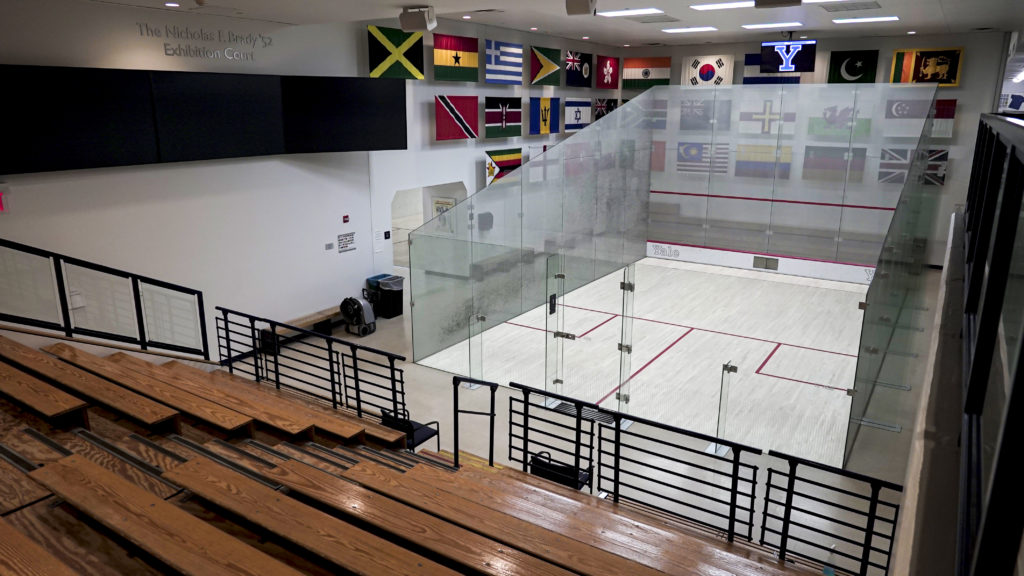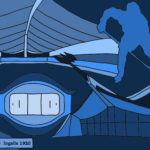Behind The Venue: A history of the Brady Squash Center
In 1999, Nicholas F. Brady’s ’52 donation of $3 million helped Yale transform into an American squash destination. The Brady Squash Center now serves as a home for Yale’s varsity players, New Haven youth and competitors from around the world.

Anasthasia Shilov, Illustrations Editor, and Zully Arias, Production and Design Editor
“Behind the Venue” is a series of feature-form articles that dives into the history, character and most memorable moments of Yale’s various athletic forums — from stadiums and fields to pools and boathouses. While not all articles in the series will resemble one another, all attempt to take a deeper look into how these places came to be and how they have fared over time. This is the third article in the series.
Located on the fourth floor of Yale’s Payne Whitney Gymnasium, the Brady Squash Center has welcomed thousands of squash players from around the world since it was built in the fall of 1999, fulfilling the vision of former Yale squash captain Nicholas Brady ’52.
In 1994, United States Squash significantly altered the U.S. squash game. Gone were the days of the American variation of hardball squash, and in came the international game with its softer ball and smaller court. This left Yale’s old squash facility, with its 28 American-style courts, obsolete. Yale would have to step up and renovate the courts and needed to raise around $7 million in order to complete this daunting task. Theodore Shen ’66 presented a gift in 1995 to begin the construction of six new courts, now known as the Theodore Shen Wing in the Brady Center. Henry “Sam” Chauncey ’57, a former Yale administrator, was tabbed to find funding for the rest of the facility.
“The Brady” now consists of 15 international singles courts, most notably the unique four-glass-wall Brady Court.
“The squash game was changing, and the institutions had to change their facilities,” Chauncey said. “There was a kind of pressure on it, sort of like the pressure that developed for artificial turf in soccer. The movement got going and you had to change.”
Chauncey said that at first, the University wanted a new squash center out in West Haven, similar to the Cullman-Heyman Tennis Center. However, because squash is a winter sport, they decided to keep the squash courts in Payne Whitney so that fans in New Haven would not have to make the trek.
In came Nicholas Brady, the namesake of “the Brady.”
Brady is known as the former United States Secretary of the Treasury under Presidents Ronald Reagan and George H.W. Bush. He graduated from Yale, where he was a member of the Chi Psi fraternity, in 1952. Under his leadership in his final year at Yale, Brady’s Bulldogs were crowned intercollegiate team champions in early March 1952.
Through his donations and advocacy, Brady played a significant role in transforming the center from an outdated collection of American-style squash courts to the world-class venue it is today.
Behind the donation: An international squash center
In the late ’90s, Chauncey traveled to Washington, D.C., to convince Brady to donate money to help create the new center. Though Brady thrived on playing American squash, Chauncey mentioned that Brady was “interested in modern squash,” a reference to international-style play, because of the global nature of the sport. Brady was a very international figure in U.S. politics, most known for “Brady Bonds,” his debt-reduction strategy in Latin America during his time as the Secretary of the Treasury. Chauncey mentioned Brady’s identity as an international figure — setting his sights on the international aspects of squash followed naturally.
Chauncey convinced Brady to give a major gift of $3 million.
“When I was first approached about the possibility of creating the number-one squash facility in the world at Yale, it had immediate appeal,” Brady told the Yale Bulletin at the opening of the center in 2000.

According to Chauncey, in order to create a first-class squash facility, having at least 15 courts is essential. Squash teams carry 18 players, with two players to a court, so for both the men’s and women’s teams to practice simultaneously, a facility would need approximately 15 courts. Former Yale squash head coach Dave Talbott, who recently retired after 38 years with the Blue and White, also mentioned how revolutionary the center was when it opened.
“We were the first to really build a big international squash center with more than six or eight courts — 15 courts, three exhibition courts with all of them having stands,” Talbott said. “It’s just an awesome center.”
Harrison Gill ’22, current captain of Yale’s men’s squash team, also credits Brady for making New Haven a major center of U.S. squash.
Yale and New Haven regularly host events like the U.S. Junior Open Squash Tournament that draw thousands of squash players from around the world to the Elm City. Chauncey said that visitors traveling to New Haven for Yale-hosted squash tournaments account for more hotel nights than anytime other than commencement.
“Because of how big the facility is, it allows for both national and international squash tournaments to happen multiple times a year, which definitely is a stimulus to the local economy,” Gill said.
In addition to wanting Yale to have 15 squash courts, Brady donated because he loves the sport and wanted to give the Yale community a centralized location where squash lovers can play.
Brady also wanted Yale to be a major player in the “international game” of squash.
“Squash is truly international and the ability to attract Yale international students in a world with shrinking boundaries will stand the University well. Squash is an international game; Yale is a world-renowned institution,” Brady said in 2000. “Yale has no chance of being No. 1 in many [team] sports and years ago gave up the goal of doing so. But I am old-fashioned and I think being No. 1 is important.”
One of the center’s most notable traits is the flags that line the main exhibition court, ranging from Sri Lanka to Ghana. These flags, which represent Yale squash players’ hometowns, are a symbol of how Brady’s international vision came to fruition.

‘Where a little guy can excel’: Squash for New Haven youth
But before he signed the check, Brady had one last vision.
He was interested in seeing squash used as a way to help youngsters in the New Haven school system. After all, describing his time as a squash player, Brady told Yale in 2000 “size is not important in squash: stamina, hand-eye coordination, but mostly sheer doggedness are the qualities that lead to success. A sport where there are no barriers to entry, where a little guy can excel, is a good place to be.”
What pushed Brady over the edge to donate was Talbott’s concept of Squash Haven, a squash and education initiative that now runs out of the Brady Center and was inspired by other programs like SquashBusters at Harvard and Street Squash in New York City.
Talbott is a founder and current chair of Squash Haven. The program is “one of the leading youth development programs in the city of New Haven” and serves 125 students in middle and high school from 25 New Haven public partner schools, according to their website.
Talbott expressed his appreciation of Brady for helping his program succeed.
“Nick is the leader in what we do with Squash Haven in the sense of the facility and a big financial supporter,” Talbott said.
Prior to last March, when COVID-19 temporarily shut down the center, the men’s and women’s squash teams both volunteered weekly with Squash Haven. Gill mentioned that having the facility is “one of the biggest pluses” for the program.
Inside ‘the Brady’: Colorful courts

For women’s squash player Anika Bhargava ’22, walking into “the Brady” for the first time for a high school tournament was a memorable experience.
“I remember the first time I walked in, I was super overwhelmed, but in the best way possible,” she said. “I was like, this is where the best players in the world come to play in college. It’s all this color and noise and it was just a very cool experience.”
Chauncey played a major part in designing “the Brady” as the colorful venue it is now.
He found collections of squash posters, banners from teams Yale has competed against and panels to show Yale’s history of squash. He said that coaches often bring recruits to the fourth floor of Payne Whitney Gymnasium “to show off Yale.”
“I went around and looked at other squash facilities that had been renovated,” Chauncey said. “What struck me when I went to each one was how it looked. … It was just sort of boring to look at, so I had this idea that maybe we could make the courts colorful.”
From the fan’s perspective, Chauncey definitely played a part in creating a great experience. With the four-glass-wall court in the center, the colors from flags around the world, banners of Yale squash competitors lined up and photos from past Yale squads, players and fans can feel the different hues of Bulldog squash history throughout the venue. Add in the blur of Yale’s home whites, rival Ancient Eight colors and the flash of the squash ball: Past and present together paint an impressive canvas in “the Brady.”
The Brady Squash Center is located on 70 Tower Parkway in New Haven.
Dean Centa | dean.centa@yale.edu








